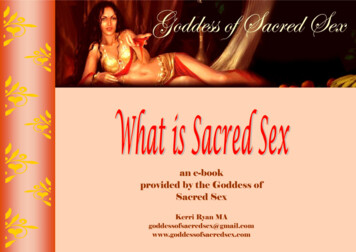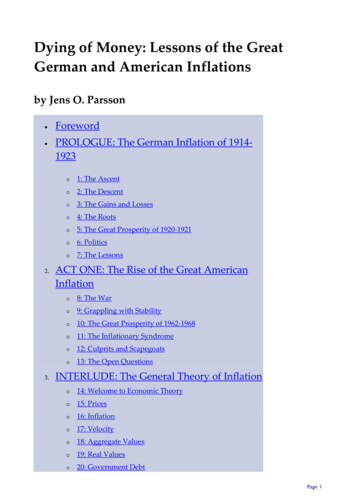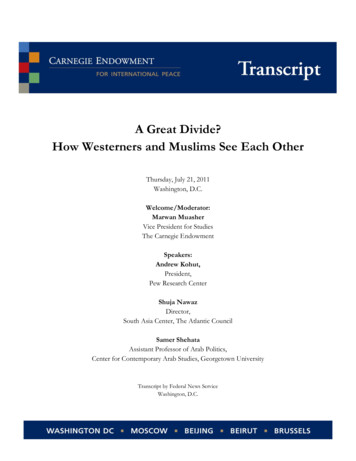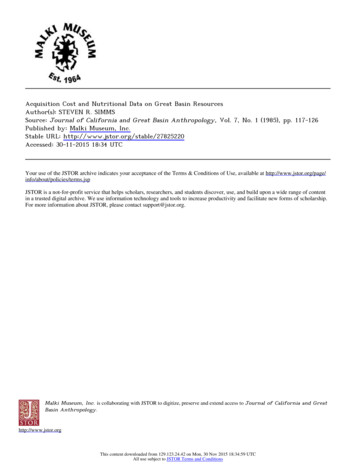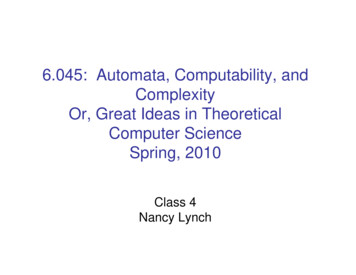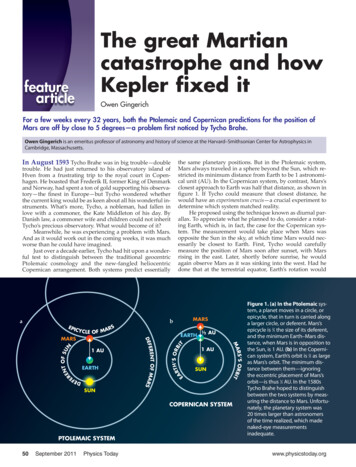
Transcription
The Great Goddess Lalitā and the Śrī CakraSubhash Kak सुभाष काकIntroductionHere we speak of the great Goddess Lalitā, who is also known as Tripurasundarī,Mahārājñī and Rājarājeśvarī amongst other names. She is the presiding deity of the mostesoteric yogic practices associated with the Śrī Cakra (also called Śrī Yantra) that arecollectively called Śrī Vidyā.According to the Vedic view, reality, which is unitary at the transcendental level, isprojected into experience that is characterized by duality and paradox. We thus haveduality associated with body and consciousness, being and becoming, greed and altruism,fate and freedom. The Gods bridge such duality in the field of imagination and alsocollectively in society (Kak, 2002): Viṣṇu is the deity of moral law, whereas Śiva isUniversal Consciousness. Conversely, the projection into processes of time and change isthrough the agency of the Goddess. Consciousness (Puruṣa) and Nature (Prakṛti) areopposite sides of the same coin.The mystery of reality may be seen through the perspectives of language (because at itsdeepest level it embodies structures of consciousness) and logic (nyāya), physicalcategories (vaiśeṣika), creation at the personal or the psychological level (sāṅkhya),synthesis of experience (yoga), analysis of tradition (mīmāṃsā), and cosmology(vedānta). These are the six darśanas of Indian philosophy. More particularly, sages haveargued that the yogic journey into the deepest point of our being, a practice that ispopularly called Tantra, is the quickest way to understanding.As our ordinary conception of who we are is determined by name and form (nāmarūpa),this journey requires challenging our most basic beliefs related to our personal and socialselves. One needs to travel to the deepest layers of our being wherein spring our desires,some of which are primal and others that are shaped by culture and experience. Sincename and form belong to the realm of time and change, this path is that of the Goddess.The path of the Goddess is quick, but it is filled with danger since it involvesdeconstructing one’s self and then arriving at a new synthesis. This path has been popularwith warriors, intellectuals and aesthetes and its practitioners include India’s greatestphilosophers.We explore first the question of the antiquity of the Śrī Cakra by showing that it figuresin a very early text, the Śvetāśvatara Upaniṣad (SU). The deity of the Śri Cakra is knownto us from the Brahmāṇḍa Purāṇa as Lalitā Tripurasundarī, the playful transcendentbeauty of the three cities. The meaning of the Cakra and its nine circuits will beexplained.1
The Goddess LalitāSubhash KakŚvetāśvatara’s YantraThe sage Śvetāśvatara, who belonged to the late Vedic period, asks in his Upaniṣadwhether time (kāla) or nature (svabhāva), or necessity (niyati) or chance (yādṛcchā), orPuruṣa is the primary cause of this reality. He answers in a riddle that goes:tamekanemi trivṛtaṃ ṣoḍaśāntaṃśatārdhāraṃ viṃśatipratyarābhiḥaṣṭakaiḥ � dvinimittaikamoham .1.4Who (like a wheel) has one felly with three tires, sixteen ends,fifty spokes, twenty counter-spokes,six sets of eight, one universal rope,with three paths and illusion arising from two views. SU 1.4This looks like the description of a Yantra, but we don’t have enough information on howto proceed to draw it. An interpretation of these numbers as different categories ofSāṅkhya was provided by Śaṅkara (788-820) although he did not specifically address itsgraphical design.We argue that this describes the Śrī Cakra. This might appear surprising at first becausethe Śvetāśvatara Upaniṣad extols Rudra-Śiva and the Śrī Cakra is associated with theGoddess. But since Śiva does reside at the innermost point (bindu) of the Cakra alongwith the Goddess, it is not inconsistent with the focus of the Śvetāśvatara Upaniṣad.Furthermore, SU 4.9 proclaims: māyāṃ tu prakṛti vidyānmāyinaṃ tu maheśvaram,consider Nature to be magical (māyā) and the Great Lord (Maheśvara) to be the one whohas cast the spell (māyin). The Goddess is another name by which Nature is known,therefore the mystery of the Lord in the launching of the Universe can only be knownthrough the Goddess. The identification of the Śrī Cakra in SU goes against the scholarlyview that the Śrī Cakra is a post-major-Upaniṣadic innovation, and, if accepted, this callsfor a revision of the history of the development of Tantra.The bindu or dot in the innermost triangle of the Śrī Cakra represents the potential of thenon-dual Śiva-Śakti. When this potential separates into prakāśa (the aham or Iconsciousness, Śiva) and vimarśa (the idam or this-consciousness, Śakti) it is embodiedinto nāda, kalā and bindu. Nāda is the primal, unexpressed sound (interpreted by humanear as oṃkāra) and kalā is the “kāma kalā,” the desire to create, which the Vedas tell usis the desire “May I be many” (Chāndogya Up. 6.2.1.3). Bindu, as the potential universeready to separate into various categories is Mahātripurasundarī. Śiva as Prakāśa(luminosity or consciousness) has realized himself as “I am”, through her, the VimarśaŚakti (Nature as the reflector).It must be stated that within the Yogic tradition, it has always been believed that Tantra isa part of the Vedas itself. In the Devī Sūkta (Ṛgveda 10.125), the Goddess describesherself as supreme. In the Śrī Sūkta of the Ṛgvedic hymns (appendices), the goddess Śrīis associated with prosperity, wealth, and fortune, and she is spoken of as deriving joy2
The Goddess LalitāSubhash Kakfrom trumpeting elephants. The Śrī Sūkta, addressed to Jātavedas of Fire, was invoked atthe fire ritual. In Kauṭilya’s Arthaśāstra (14.117.1) there is reference to the goddess beinginvoked for the protection of a fort. In the Bṛhadāraṇyaka Upaniṣad 7.4 there is areference to the goddess Vāc.The Vedic triads, together with the dyadic male and female components, enlarge throughexpansion (prapañca) so the universe is a projection (vimarśa) of the Absolute’s selfillumination (prakāśa).The supreme deity in the form of Śakti (parāśakti), Śrī as the great goddess (mahādevī) isone of the aspects of Lalitā Tripurasundarī. Lalitā Tripurasundarī has threemanifestations: sthūla, or descriptive as image; sūkṣma, or subtle as mantra; and parā, ortranscendent as yantra or cakra. Lalitā Tripurasundarī is also called Rājarājeśvarī or justŚrīdevī. Those who see the three representations as interrelated are called the followers ofthe kaula tradition, as has been the case with the Kashmiris.In the South, the Tirumantiram (Śrīmantra in Sanskrit) of the seventh century siddhaTirumular knows Śrīvidyā. In the Lalitāsahasranāma, Lalitā is described in terms similarto those of Durgā. Lalitā is worshiped as the srividyā mantra and as the Śri Yantra.The Śrīvidyā mantra is known in three forms: kādi (starting with ka), hādi (starting withha), and sādi associated with Śri Manmatha, Lopāmudrā, and Durvāsā respectively. Themantra is divided into three parts, which represent three sections (kūṭa or khaṇḍa) of theimage of the Goddess: vāgbhavakūṭa, kāmarājakūṭa, and śaktikūṭa.The kādividyā of Śri Manmatha:ka e ī la hrīm (vāgbhavakūṭa)ha sa ka ha la hrīm (kāmarājakūṭa)sa ka la hrīm (śaktikūṭa)The hādividyā of Lopāmudrā:ha sa ka la hrīm (vāgbhavakūṭa)ha sa ja ha la hrīm (kāmarājakūṭa)sa ka la hrīm (śaktikūṭa)The sādividyā of Durvāsā:sa e ī la hrīm (vāgbhavakūṭa)sa ha ka ha la hrīm (kāmarājakūṭa)sa ka la hrīm (śaktikūṭa)The 18th century scholar Bhāskarāya maintained that the Śrīvidyā mantra is meant inRgveda 5.47.4 where it is said: catvāra īṃ bibharti kṣemayantaḥ, “that with four īṃs3
The Goddess LalitāSubhash Kakconfers benefit”. The kādi mantra (pañcadaśākṣarī) has four long ī vowels. Accordingto some, the 16-syllable mantra (ṣoḍaśākṣarī) is obtained by adding the seed-syllable(bījākṣara) śrīṃ to the 15-syllable mantra.The Śri Vidyā mantra is viewed as 37 syllables, representing the 36 tattvas of reality ofŚaivism and the 37th transcendent Parāśiva state. These are divided into 11 for thevāgbhavakūṭa, 15 for the kāmarājakūṭa, and 11 for the śaktikūṭa.The Śrī Cakra and Lalitā TripurasundarīThe three cities in the name of Lalitā Tripurasundarī are that of the body, the mind, andthe spirit, or that of will (icchā), knowledge (jñāna) and action (kriyā). They may also beseen as the knower, the means of knowledge, and the object of knowledge; the threegunas of sattva, rajas and tamas; agni (fire), sūrya (sun) and candra (moon); sṛṣṭi(creation), sthiti (preservation) and laya (dissolution); intellect, feelings, and sensation;subject (mātā), instrument (māna), and object (meya) of all things; waking (jāgrat),dreaming (svapna) and dreamless sleep (suṣupti) states; as ātma (individual self),antarātma (inner being) and paramātma (supreme self) and also as past, present andfuture.Her five triangles represent the pañca bhūtas (five elements). She holds five floweryarrows, noose, goad and bow. The noose is attachment, the goad is revulsion, the bow isthe mind and the flowery arrows are the five sense objects. Their union is harmony orsamarasa.Śaṅkara (788-820) spoke of the Śri Cakra in the Saundaryalaharī (SL) (Subramaniam,1977). In SL11, the Śri Cakra is described in terms of its 4 Śrikaṇṭha (upward pointing)and 5 Śivayuvatī (downward pointing) triangles, which create its 43 triangles. If we lookŚrī Cakra’s structure as consisting of three basic triangles, then within each triangle arelower hierarchical levels of two other triangles, of alternating polarity. The 42 outertriangles are arranged in four circles around the middle triangle, with counts of 8, 10, 10,and 14 in the four arrays. The Śrī Cakra is also associated with the cakras of the yogi’sbody. According to SL 14:Fifty-six for earth (mūlādhāra); for water fifty-two (maṇi-pūraka),sixty-two for fire (svādhiṣṭhāna); for air fifty-four (anāhata),seventy-two for ether (viśuddhi); for mind sixty-four (ājña cakra)are the rays; even beyond these are your twin feet.The six cakras are classified in granthis (knots) of two. The lowest two cakrascorrespond to 108 rays, the middle two to 116, and highest two to 136 rays. I have arguedelsewhere that this provides an explanation for the layout of the great Śiva temple atPrambanan in Indonesia (Kak, 2010)The Śrī Cakra embodies the tripartite division of the cosmos into earth, atmosphere, andthe sun, which is mirrored in the individual by the body, the breath, and the inner lamp of4
The Goddess LalitāSubhash Kakconsciousness; it also represents the three parts of the body: neck to head, neck to navel,and navel to the bottom of the trunk. It is within the wheel of time (kālacakra), and it isboth the human body (microcosm) and the universe (macrocosm). Its middle 43 trianglesare surrounded by a circle of 8 petals that, in turn, is surrounded by a 16-petalled circle.At the outermost are 3 lines, which are called the bhūpura. They are also categorized into9 circuits or āvaraṇas, where the bhūpura is the outermost āvaraṇa. These 9 āvaraṇashave 108 presiding Devis. In the Śrī Cakra pūjā they are systematically worshipped oneby one with their names and mantras. The nine circuits symbolically indicate thesuccessive phases in the process of becoming.The nine cakras are compared in the Tripura Upaniṣad to the nine yogas, namely theeight familiar ones of Patañjali and the additional one of sahaja.The Śrī CakraLalitā Tripurasundarī’s three śaktis, which are shown in the three corners of the innertriangle, are Bhagamālinī, Vajreśī, and Kāmeśvarī, who are associated with Brahmā,Viṣṇu, and Rudra. The central bindu is where the Goddess is united with Śiva, theUniversal Consciousness.Cakra pūja or Yantra pūja is the worship of the deity. Devi, the cosmic female force, isthe first step of creation. The counterpoint male principle has three emanations: Rudrafrom the left, Brahmā from the middle, and Viṣṇu from the right. At the centre of the ŚriYantra is kāmakalā, which has three bindus. One is red, one is white and one is mixed.The red bindu is Kurukulla, the female form; the white bindu is Vārāhi the male form;and the mixed bindu is the union of Śiva and Śakti.5
The Goddess LalitāLalitā TripurasundarīSubhash KakForty-three triangles of the Śrī CakraLooking at the Śrī Cakra from outside in within the circular part of the Yantra, we thushave one felly with 3 tires, 16 ends of the petals in the outer circle, and a total of 50 (8petals and 42 triangles outside of the central one) “spokes”, with 20 triangles in themiddle two circuits that may be termed “counter-spokes”, a total of six circuits of petalsand triangles have either 8 or more than 8 members, the universal rope is the bhūpura, thethree paths are the paths ruled by tamas, rajas, and sattva embodied by the threeGoddesses in the innermost triangle.The Śrī Cakra maps the inner sky as one goes from outside to inside; it is also located inthe body in terms of the 6 cakras. The count of 50 of the Śrī Cakra is mapped to 50 petalsof the cakras as one goes from the base (mūlādhāra) to the ājña cakra. The specificnumber of lotuses is 4, 6, 10, 12, 16, and 2. The sahasrāra cakra’s 1000 petals parallelthe infinity associated with the innermost triangle of the Śrī Cakra.Inside the square are three concentric circles, girdles (mekhalā). The space between thesquare and three girdles is the Trailokyamohana cakra, or the cakra that enchants thethree worlds; at this stage the adept sees himself as his social self completely immersed inthe magic of life.Next are two concentric rings of sixteen and eight lotus petals, respectively. The first ofthese is Sarvāśāparipūraka cakra, which is the cakra that fulfils all desires; the second isthe Sarvasānkṣobhaṇa cakra, indicating dissolution of apartness and duality.The fourth cakra, consisting of the fourteen triangles forming the outer rim of thecomplex interlocking of triangles, is the Sarvasaubhāgyadāyaka, giver of good fortune,which leads one to spiritual insight and success.
The Goddess Lalitā Subhash Kak 2 Śvetāśvatara’s Yantra The sage Śvetāśvatara, who belonged to the late Vedic period, asks in his Upaniṣad whether time (kāla) or nature (svabhāva), or necessity (niyati) or chance (yādṛcchā), or Puruṣa is the primary cause of this reality. He answers in a riddle that goes:
